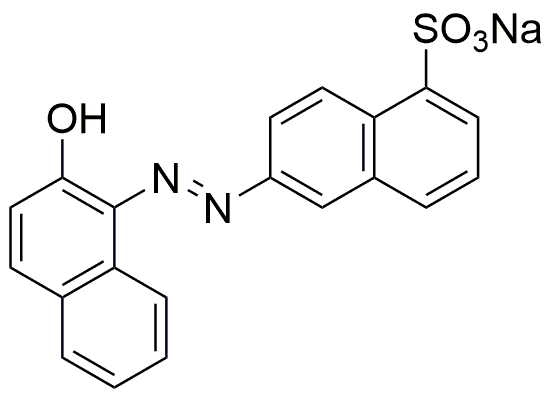Acid red 9 is widely utilized in research focused on:
- Dyeing Textiles: This compound is commonly used in the textile industry for dyeing fabrics, providing vibrant red colors that are durable and resistant to fading.
- Food Coloring: It serves as a food dye, adding color to various products such as candies and beverages, while meeting regulatory standards for safety.
- Biological Staining: In laboratories, Acid red 9 is used for staining biological samples, aiding in the visualization of cellular structures under a microscope.
- Cosmetic Formulations: The compound is incorporated into cosmetic products, offering a safe coloring agent for items like lipsticks and blushes.
- Research Applications: It is utilized in various research studies, particularly in the fields of chemistry and biology, to explore the interactions of dyes with different materials and biological systems.
General Information
Properties
Safety and Regulations
Applications
Acid red 9 is widely utilized in research focused on:
- Dyeing Textiles: This compound is commonly used in the textile industry for dyeing fabrics, providing vibrant red colors that are durable and resistant to fading.
- Food Coloring: It serves as a food dye, adding color to various products such as candies and beverages, while meeting regulatory standards for safety.
- Biological Staining: In laboratories, Acid red 9 is used for staining biological samples, aiding in the visualization of cellular structures under a microscope.
- Cosmetic Formulations: The compound is incorporated into cosmetic products, offering a safe coloring agent for items like lipsticks and blushes.
- Research Applications: It is utilized in various research studies, particularly in the fields of chemistry and biology, to explore the interactions of dyes with different materials and biological systems.
Documents
Safety Data Sheets (SDS)
The SDS provides comprehensive safety information on handling, storage, and disposal of the product.
Product Specification (PS)
The PS provides a comprehensive breakdown of the product’s properties, including chemical composition, physical state, purity, and storage requirements. It also details acceptable quality ranges and the product's intended applications.
Certificates of Analysis (COA)
Search for Certificates of Analysis (COA) by entering the products Lot Number. Lot and Batch Numbers can be found on a product’s label following the words ‘Lot’ or ‘Batch’.
*Catalog Number
*Lot Number
Certificates Of Origin (COO)
This COO confirms the country where the product was manufactured, and also details the materials and components used in it and whether it is derived from natural, synthetic, or other specific sources. This certificate may be required for customs, trade, and regulatory compliance.
*Catalog Number
*Lot Number
Safety Data Sheets (SDS)
The SDS provides comprehensive safety information on handling, storage, and disposal of the product.
DownloadProduct Specification (PS)
The PS provides a comprehensive breakdown of the product’s properties, including chemical composition, physical state, purity, and storage requirements. It also details acceptable quality ranges and the product's intended applications.
DownloadCertificates of Analysis (COA)
Search for Certificates of Analysis (COA) by entering the products Lot Number. Lot and Batch Numbers can be found on a product’s label following the words ‘Lot’ or ‘Batch’.
*Catalog Number
*Lot Number
Certificates Of Origin (COO)
This COO confirms the country where the product was manufactured, and also details the materials and components used in it and whether it is derived from natural, synthetic, or other specific sources. This certificate may be required for customs, trade, and regulatory compliance.


